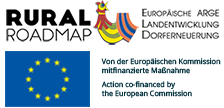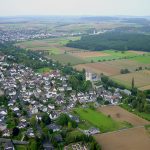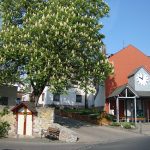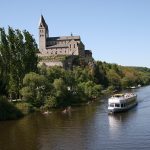Dietkirchen, Hesse, Germany
Dietkirchen with its some 1.750 inhabitants is part of the district capital of Limburg an der Lahn and is located on the western shore of the river. Visible from afar are the remarkable limestone cliffs with a romantic basilica.
Since the 2. World War, the village has almost doubled its original population of around 1.000 inhabitants. The village has become residence for commuters – mainly to the close-by city of Limburg an der Lahn. A stop will be put to this development now with the determination of stopping the designation of building land. However, the settlement pressure remains and thus leads to a positive revitalisation of existing building stock. This includes the few remaining historic farms, unoccupied houses along the highly trafficked main road as well as houses of the 1950ies resettlers. Architects on site offer pro-bono advice and act as role models with their own reconstructions.
Another focal point regarding construction is redesigning public locations within the core of the village that have suffered from the traffic routing of the past decades and are now revitalized. A skywalk for cyclists and pedestrians across the Lahn shortens the distance to the regional train station in Eschhofen by 2 kilometres and also makes accessible the bikewaysof the Lahn tourism association on the left riverside.
New conventional commercial areas with supermarkets on the outskirts of the municipality relocate shopping out of the village and thereby reduce the space between Dietkirchen, the highway and Limburg an der Lahn even further. Tree-lined access roads aim to visually counteract this development
Exemplary reconstructions of former farms for new multiple-generations-housing and -working as well as the renovation of valuable building stock within the core of the village represent the new identity of Dietkirchen. Also remarkable is the installation of the old, unemployable church clock.
According to a demographic prognosis, 20% less young people, but 25% more elderly people will inhabit Dietkirchen by 2020. Consequently, Dietkirchen tries to react to this development by increasing the socio-cultural quality – for example by using the parish community center as a youth center or by creating a social center for geriatric care. There are plans for a integrative meeting center with homework supervision, work shop area, internet café, lunch table and communal activities for the elderly and the young as well as new shared living forms such as multiple-generation-houses and senior living communities. Also remarkable is the “Civic fund Dietkirchen”. All income from voluntary work at communal festivities and activities is collected here and distributed to residents in need.
Identification of the population with the village and its associations is high, as shown by the outstanding membership numbers: the sports club has around 1.000 members, the voluntary fire department circa 300, including inhabitants of neighbouring villages. These incredible numbers can also be attributed to the fact that their offers not only appeal to the youth, but also to senior citizens.
Also, the high individual participation concerning the funding of projects is extraordinary. The project of the athletics and sports club – including the construction of a new club house and an artificial grass pitch – was funded primarily through personal contributions from club members. The reconstruction of the village community house as wel as other small community centres was undertaken in a similar matter.
The high determination of Dietkirchen’s inhabitants to be socially active is based on two pillars: The first would be the vivid club life which is not only focused on immediate club issues, but also on the expansion of communal meeting opportunities. The second pillar is the working group village renewal, which succeeded to sensitise the population for its structural environment and for high-quality development of social and cultural areas.
Evaluated: 2012



